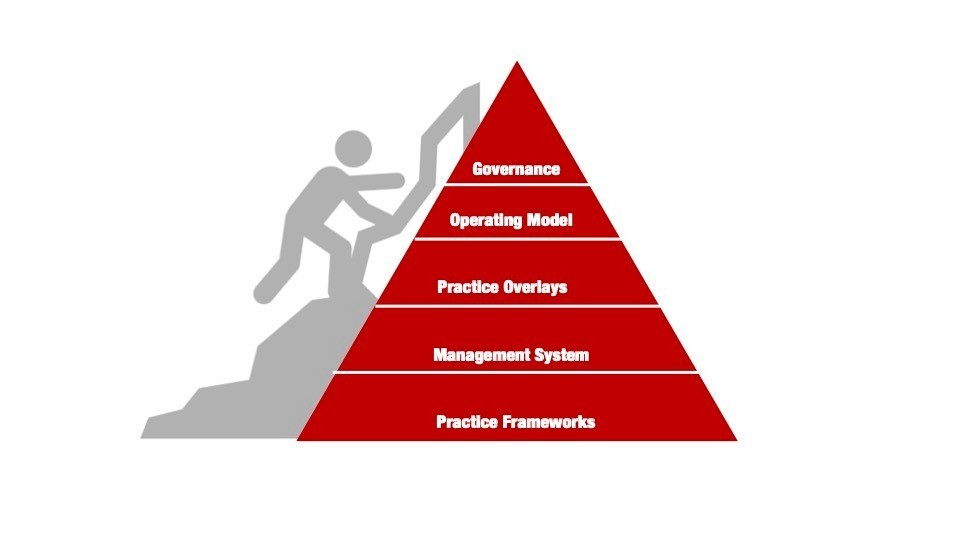A post by our guest editor, John Worthington. A follow-up to part 1 - The Mountaintop Fallacy - this is part 2.
What Each Layer Really Does
Overlays, Operating Models, and Practices—Stop Mixing Your Metaphors
You’ve seen the slide.
One of those strategy decks with a 'service model' that looks more like a layer cake: Governance on top, Agile and DevOps on the bottom, and a bunch of acronyms in the middle to keep it all glued together.
No one questions it. Everyone nods. Someone mutters 'alignment.'
But here’s the uncomfortable truth:
We’ve been mixing metaphors for years. And it’s costing us clarity, coherence, and control.
It’s time we sorted it out.
🧩 The Five-Layer Stack—Explained
Let’s lay this out cleanly. You don’t need a PhD in frameworks—just a working compass and a little honesty.

Let’s take a moment to define each one—and why confusing them breaks everything.
🧭 1. Governance & Policy
This is the top of the pyramid. It defines purpose, constraints, and direction.
- Sets values
- Defines acceptable risk
- Establishes compliance
- Aligns the organization with its external stakeholders
🧠 It doesn’t tell you how to do things. It tells you why you’re doing them—and what boundaries not to cross.
🏗️ 2. Operating Model
This is your organizational design and capability map. It translates governance into structure.
- Lays out value streams or delivery chains
- Defines decision rights and accountability
- Organizes capabilities across functions or domains
🧠 It’s the blueprint. But blueprints don’t build buildings.
🧩 3. Practice Overlays
This is where things get slippery. Overlays like SIAM, DVMS, and HumanizingIT don’t replace your system—they sit atop it to guide coordination, integration, or value management.
- SIAM coordinates multiple providers
- DVMS connects digital value to governance
- XLA overlays shift focus from SLA to experience
🧠 They assume your house has walls. They don’t supply the bricks.
🧱 4. Management System
Here’s the part everyone forgets—or wrongly outsources to their ticketing tool.
The management system is what actually binds governance to execution:
- Defines profiles (e.g., Customer, Provider, Operator)
- Establishes repeatable processes and workflows
- Applies logic to govern services at scale
- Is recursive (can be applied across all levels and providers)
🧠 This is the glue, the chassis, the operational engine. USM is a great example of one. Most orgs don’t actually have one—and it shows.
🧰 5. Contextual Practices
Here’s where the rubber meets the road. Practices are toolkits you can apply to solve local problems.
- ITIL for incident/change/service
- DevOps for flow and feedback
- Agile for iterative delivery
- SAFe for scaled execution
- IT4IT for toolchain reference models
🧠 These are power tools, not operating systems. Use them wisely—but never confuse them for structure.
🚧 Why Frameworks ≠ Systems
Let’s get this straight:¹¹

A framework is like a recipe. A system is like a kitchen. Without the kitchen, you’re cooking on the floor.
💣 Why Overlays Only Work When Something Solid Lies Beneath
Overlays are fantastic. Until they aren’t.
Without a real management system:
- SIAM becomes chaos wrapped in PowerPoint
- DVMS becomes governance theater
- Agile becomes tribal warfare
- Tools become the de facto “system”
But with a management system like USM in place:
- Roles are clearly defined across every team and provider
- Workflows are standardized
- Governance flows downward and evidence flows upward
- Overlays actually do what they’re designed to do
“Overlays coordinate, practices execute, governance directs. But only the management system binds them.”
📍 Coming Up in Part 3:
We’ll look at the different stakeholder perspectives—executives, architects, practitioners—and how each one misunderstands or overlooks the management system in their own way.
You’ll see why they all think someone else is handling it—and why that assumption breaks things.
💬 Question for You:
Have you ever worked in an organization where strategy and execution felt completely disconnected? Where every team was 'agile' but no one could explain who owned what? Where governance showed up once a year in audit season and never again?
What was missing?
Drop your thoughts. Let's compare scars.
==/==
![]() If you enjoyed John's post and it made you think about improving your own organization, please check out his USM Professional profile and his personal website, or better: contact John for a free consultation.
If you enjoyed John's post and it made you think about improving your own organization, please check out his USM Professional profile and his personal website, or better: contact John for a free consultation.
John has posted this blog earlier in his USM method News LinkedIN newsletter. If you want to read his posts when they're published - subscribe to John's channel.

